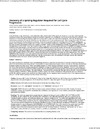Identificador persistente para citar o vincular este elemento:
https://accedacris.ulpgc.es/jspui/handle/10553/73991
| Título: | Discovery of a Splicing Regulator Required for Cell Cycle Progression | Autores/as: | Suvorova, Elena S. Croken, Matthew Kratzer, Stella Ting, Li-Min Conde De Felipe, Magnolia María Balu, Bharath Markillie, Meng L. Weiss, Louis M. Kim, Kami White, Michael W. |
Clasificación UNESCO: | 310907 Patología 320712 Parasitología |
Palabras clave: | Parasite Toxoplasma-Gondii Gene-Expression Fission Yeast Saccharomyces-Cerevisiae Division Cycle, et al. |
Fecha de publicación: | 2013 | Publicación seriada: | PLoS Genetics | Resumen: | In the G1 phase of the cell division cycle, eukaryotic cells prepare many of the resources necessary for a new round of growth including renewal of the transcriptional and protein synthetic capacities and building the machinery for chromosome replication. The function of G1 has an early evolutionary origin and is preserved in single and multicellular organisms, although the regulatory mechanisms conducting G1 specific functions are only understood in a few model eukaryotes. Here we describe a new G1 mutant from an ancient family of apicomplexan protozoans. Toxoplasma gondii temperature-sensitive mutant 12-109C6 conditionally arrests in the G1 phase due to a single point mutation in a novel protein containing a single RNA-recognition-motif (TgRRM1). The resulting tyrosine to asparagine amino acid change in TgRRM1 causes severe temperature instability that generates an effective null phenotype for this protein when the mutant is shifted to the restrictive temperature. Orthologs of TgRRM1 are widely conserved in diverse eukaryote lineages, and the human counterpart (RBM42) can functionally replace the missing Toxoplasma factor. Transcriptome studies demonstrate that gene expression is downregulated in the mutant at the restrictive temperature due to a severe defect in splicing that affects both cell cycle and constitutively expressed mRNAs. The interaction of TgRRM1 with factors of the tri-SNP complex (U4/U6 & U5 snRNPs) indicate this factor may be required to assemble an active spliceosome. Thus, the TgRRM1 family of proteins is an unrecognized and evolutionarily conserved class of splicing regulators. This study demonstrates investigations into diverse unicellular eukaryotes, like the Apicomplexa, have the potential to yield new insights into important mechanisms conserved across modern eukaryotic kingdoms. | URI: | https://accedacris.ulpgc.es/handle/10553/73991 | ISSN: | 1553-7390 | DOI: | 10.1371/journal.pgen.1003305 | Fuente: | Plos Genetics [ISSN 1553-7404], v. 9 (2), e1003305, (Febrero 2013) |
| Colección: | Artículos |
Citas SCOPUSTM
33
actualizado el 08-jun-2025
Citas de WEB OF SCIENCETM
Citations
33
actualizado el 08-jun-2025
Visitas
128
actualizado el 01-feb-2025
Descargas
105
actualizado el 01-feb-2025
Google ScholarTM
Verifica
Altmetric
Comparte
Exporta metadatos
Los elementos en ULPGC accedaCRIS están protegidos por derechos de autor con todos los derechos reservados, a menos que se indique lo contrario.
